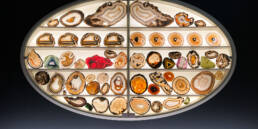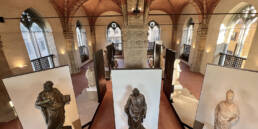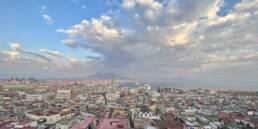A while ago a cousin visited and I had an hour with her before we went to dinner. After that, she’d be on her own in Florence for a few days and, as a resident recovering art historian, I felt responsible for ensuring that she received at least a bit of a historical base with which to explore the city. My version of an introductory walking tour to Florence focuses on four well-known spots in the dense historic center; just about any tourist will see these places, but chances are they won’t get the kind of information that comes to my art- and history-focused mind. With these facts, however, you’ll be rather well equipped to approach the rest of the city. As a fabulous challenge, I summarized this post in a 90-second reel; read below for a few more details and links to longer articles that will really help you out when you visit!
PS although you can explore Florence on your own, I always heartily recommend the very informed guides from Context Travel – if you’re planning a trip, check out their Florence Tours.
Piazza della Signoria

Piazza della Signoria houses our city hall, Palazzo Vecchio. This building dates from Florence’s Second Republican government and was begun in 1299. Due to the spatial constraints of building in a densely populated medieval city, they had to make use of an existing open space, causing an irregularly-shaped piazza out front and to the sides (it actually expanded over time and was initially smaller than what you see today). To build quickly and efficiently, they also started with extant buildings, like using a tower house’s foundations, explaining the way the building’s high tower is off-center. Fun fact, nobody was allowed to have a tower taller than that of the government’s. Wealthy residents in town in fact had “tower houses”, tall stone buildings with not many openings that were a sign of power and were in fact safe places in what was a rather violent time full of factional fighting in the streets.
One could go on at length about how, in this piazza, all the decorations have political meanings. When Palazzo Vecchio was first built, it wasn’t decorated at all, and was deliberately scary looking, employing crenellation, the shape of the top of the tower that recalls fortresses. With time, the piazza gained sculptures, from the not very threatening lion by Donatello to the Neptune fountain with the face of Grande Duke Cosimo the first de’Medici and of course including Michelangelo’s David. While some of these were not made for this space, when they were moved here they were given political meanings in line with whoever occupied the government at the time.
Back when I used to teach art history to study abroad university students, I gave a much more in-depth presentation of this piazza; this blog post from 2008 is based on my teaching notes!
Orsanmichele

About halfway between Palazzo Vecchio and the Duomo, don’t miss Orsanmichele, a building that served civic and religious functions AND happens to be the epicenter of the birth of Renaissance sculpture. This building was the city’s granary, built in 1336. The ground floor was open for commerce while grain was stored upstairs. A miraculous Madonna started attracting visitors and money, so the space was subsequently enclosed and decorated. It’s free to go inside the church and admire the painting in an elaborate marble loggia, though it’s currently closed for renovation.
At the start of the 15th century, the city’s guilds were given the task of each providing a sculpture for one of the 14 gothic arches on the outside of the building. Hiring Florence’s most established as well as up-and-coming artists made an open-air museum. While “major” guilds were asked to commission sculptures in bronze, for which the highly established Ghiberti was the top choice, the “minor” guilds were only allowed to use marble, and their lower budgets pointed them towards the young Donatello, who would become perhaps one of the most famous artists of all time and who started his career right here. The statues outside are all copies, and most of the originals are housed in a museum on the top floor that is open only on Mondays (when many other things are closed). Others are housed elsewhere in the city, namely the Bargello and Opera del Duomo museums.
Find out more about Renaissance sculpture by visiting the Bargello: in this article I summarize the don’t miss sculptures at the Bargello.
Piazza della Repubblica
I always stop here with visitors to point out how this wide space represents two important historical moments in Florence. First of all, this was once the center of the Roman city, the Castrum Romano. If you look at a map, observe how the streets from here go in a grid system established by the Romans. Beyond a controlled rectangle of grid streets that was the original city, growth in the middle ages was more organic, following the shape of the river.

We often look at this wide open space as an attractive and regular feature that we expect to find in a European city. That’s exactly why it is what it is now. Because in the middle ages and in Renaissance times, this area was a crowded market and at some point the Jewish Ghetto, and not a very safe place to be. When Florence was going to be the capital of Italy, which it was from 1865-70 area, the architect in charge of making the city appropriate for the task knocked it all down to make the grand space you see today (he also knocked down the city walls to create the viali or ring roads). They celebrated the clean-up by writing the inscription you see over the arch that translates as “The ancient centre of the city restored from age-old squalor to new life.”
Piazza Duomo

A lot of people might start their visit of Florence in piazza Duomo, which certainly is a lot of “bang for your buck”. The famous cupola is so tall and imposing, before the modern age it must have been shocking to come upon it and it could be seen from many miles away. Even today, it looms over the city center’s dense streets and you can use it to orient yourself when you’re lost!
This is the religious heart of the city. Only in Tuscany do we have a division of the functions of a cathedral into three or more separate buildings – here, church, belltower, and baptistery. The Cathedral, or Duomo, was begun in the 1290s and took over 150 years to finish, not counting the façade which is actually from the 19th-century (in the neo-gothic style). When they started, they built on faith and with an incomplete design – they didn’t really know how they were going to put a roof on a space so wide. When the time came, they held a contest for whoever could come up with the best solution. This was won by Brunelleschi won and he topped it with the famous Cupola.
Here’s an oldie but goodie article that goes seriously into depth about the Duomo and the other buildings in this space.
Further reading
Take a look at the Florence category on this blog for almost 20 years (!!) of articles. Some of my best introductory material was published a looong time ago, so may I recommend:
- A timeline of art historical periods that will help you identify the periods in which the things you see were made
- An article about the Medici family and where to find traces of their patronage
- An introduction to the church of Santa Croce, which is another good “entry point” to the history of Florence through its religious orders
This article contains a referral link to Context Travel, a service I honestly recommend and through which I earn a small percentage.
Sign up to receive future blog posts by email
Alexandra Korey
Alexandra Korey aka @arttrav on social media, is a Florence-based writer and digital consultant. Her blog, ArtTrav has been online since 2004.
Related Posts
January 30, 2024
Florence Museum News 2024
January 5, 2024
The Architecture of Michelangelo’s Laurentian Library
September 11, 2023




